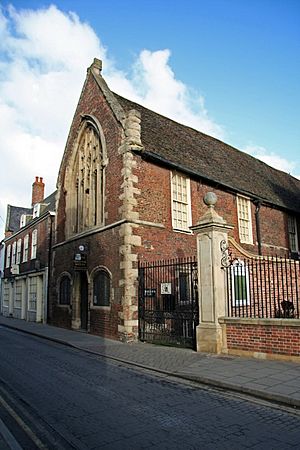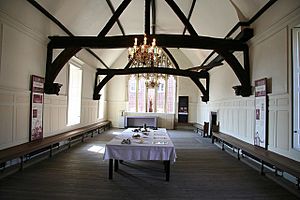Boston Guildhall facts for kids
Quick facts for kids Boston Guildhall |
|
|---|---|
 |
|
| Location | Boston, Lincolnshire |
| Built | 1390 |
|
Listed Building – Grade I
|
|
| Designated | 20 November 1975 |
| Reference no. | 1389007 |
| Lua error in Module:Location_map at line 420: attempt to index field 'wikibase' (a nil value). | |
The Boston Guildhall is a very old and important building in Boston, Lincolnshire, England. It was first built in 1390. Over many years, it has been changed and updated. Today, it is a local museum where you can learn about history. It also hosts special events like weddings. This building is so important that it is a Grade I listed building, meaning it is protected for its historical value.
Contents
A Look Back: The Guildhall's Story
The story of the Guildhall began with a group called St. Mary's Guild in Boston. This was a group of merchants, like a club for business people, started in 1260. The Guildhall building itself was built in 1390. This was just before the guild officially became a legal group.
The guild became very rich over the 1300s and 1400s. They received many valuable gifts. Records show they owned items made of gold and silver. They also had important religious items. In the 1500s, the guild even became known for selling special religious certificates.
However, things changed when King Edward VI ruled. He ordered that many religious guilds and chantries (places for prayers) be closed. Because of this, the Guildhall was taken by the King. In 1555, it was given to the Boston Corporation, which was the local government of Boston at the time.
The Pilgrim Fathers' Connection
A very famous event happened at the Guildhall in 1607. A group of Puritans, led by William Brewster, were brought here. These people are now known as the Pilgrim Fathers. They were trying to travel to Holland without the King's permission. This was against the law back then.
The magistrates (judges) at the Guildhall let them go. The Pilgrims stayed in Boston for several months. The next year, they finally reached Holland using a different route. Later, in 1620, they sailed from Plymouth on the famous ship, the Mayflower. They traveled to the New World and started a new settlement there. This settlement became part of what is now the Massachusetts Bay Colony in America.
Changes Over Time
As the 1700s arrived, the Guildhall was used more and more for town business. Many changes were made to the building. These changes covered up or removed much of its original medieval look. One writer in 1856, Pishey Thompson, said that the inside of the building looked so modern. He claimed only the roof's structure remained from the original design.
The Guildhall stopped being used as a courthouse in 1842. This was after a new courthouse, the Boston Sessions House, was built. Then, in 1904, it stopped being used for any town government roles. This happened when the new Municipal Buildings were finished.
During the First World War, the Guildhall had a restaurant that served as a soup kitchen. It also served as a special public restaurant during the Second World War. However, this restaurant had to close in 1949 due to a food safety issue. The entire building was later fully restored. This big restoration project happened after it received a lot of money in 2008.
How the Guildhall Was Built
The walls of the Guildhall are made of two layers of bricks. Between these layers is a mix of stones and rubble. The way the bricks are laid shows that the building is very old, from the late medieval period. The bricks are not perfectly shaped. They are set in thick mortar, which is like a strong glue.
The bricks are laid in a pattern where most rows are long bricks. Sometimes, a short brick is used to connect the two wall surfaces. This way of building was common before other methods became popular. Later, builders started using patterns like "English Bond" or "Flemish bond." These patterns used alternating long and short bricks in a more regular way. The mortar used to hold the bricks together was a lime-based mix. You can still see some of this original mortar in places on the building's north side.
What You Can See Inside
The Guildhall has a special collection of items. One important piece is a painting of Sir Joseph Banks. He was an important person in Boston in 1813. Sir Joseph Banks sailed with Captain James Cook on the ship Endeavour. This was during the first big journey to explore Australia.
The Guildhall also has a copy of a famous book called Foxe's Book of Martyrs. This book tells stories of people who were persecuted for their beliefs. You can also see items found during archaeological digs. These items help us learn more about the past.
See also
- Guild
- Guildhall Museum


